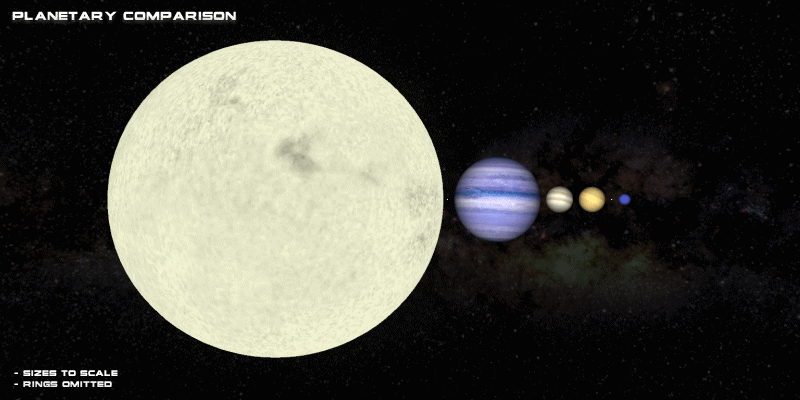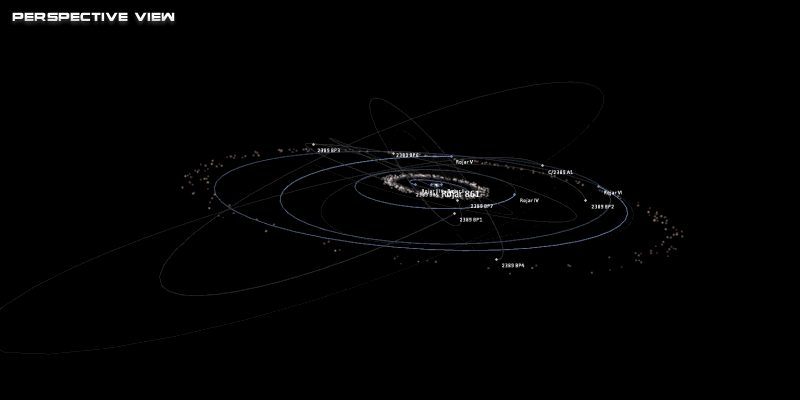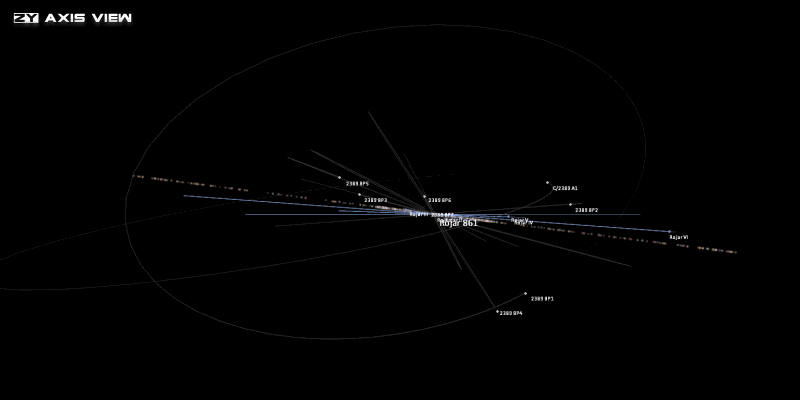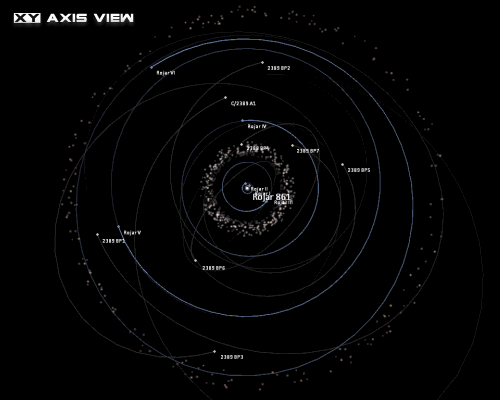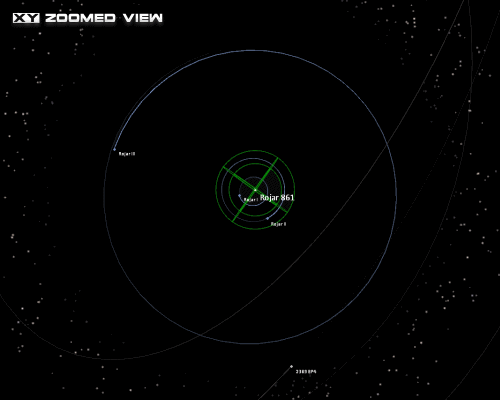02 - Star Systems
Created by Commander Morgan Tarin on 27 Oct 2023 @ 10:35am
Table of Contents:
2.1 Akkadia System
Figure 2.1.1 - Binary stars at the center of the Akkadia system
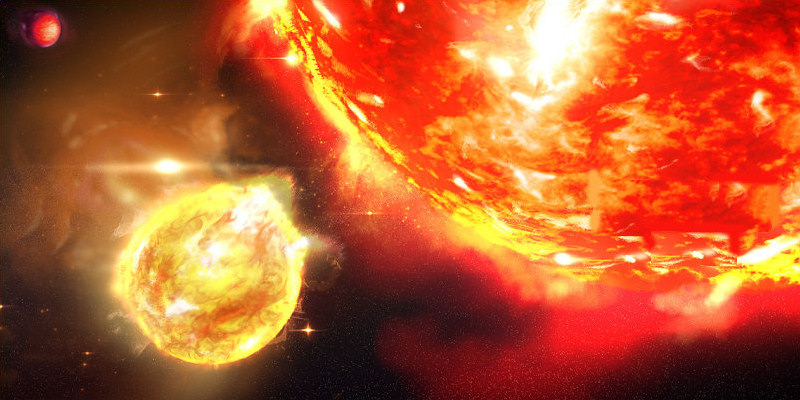
|
System Notes
|
PRIMARY STAR
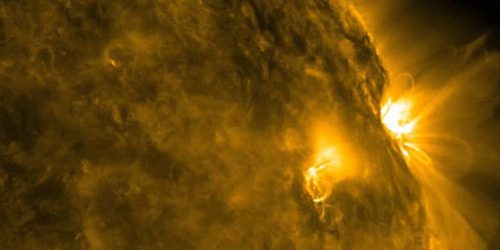
Type: Spectral Class G8V
System Location: Core
U-B Color Index: +0.22
B-V Color Index: +0.72
Variable Type: None
Mass: 0.81 M☉
Radius: 0.8160 R☉
Surface Gravity (log G): 4.4
Luminosity: 0.59 L
Temperature: 5,344 K
Metallicity: 22-74%
Rotation: 34 days
SECONDARY STAR
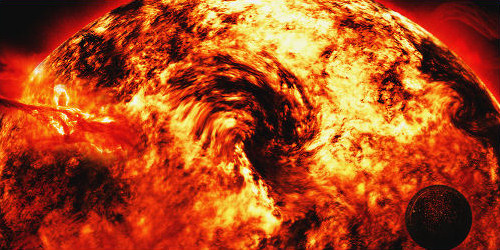
Type: Spectral Class M3V
System Location: Core
B-V Color Index: +1.61
Variable Type: None
Mass: 0.31 M☉
Radius: 0.29 R☉
Surface Gravity (log G): 4.92 (0.10)
Luminosity: 0.013 L
Temperature: 3,480 K
Metallicity (M/H): 0.33 (0.12)
AKKADIA I
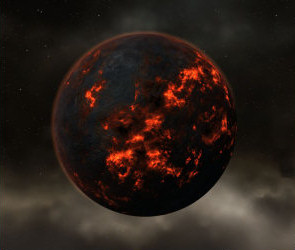
Name: Akkadia I
Type: Class B - Geomorteus
Orbital Radius: 0.0142 AU
Axial Tilt: 7 degrees
Atmosphere: None
Equatorial Radius: 0.38 Sols
Polar Radius: 0.28 Sols
Flattening: 0.25
Surface Area: 55,036,800 km2 (0.108 Sols)
Volume: 6.08 km3 (0.054 Sols)
Mass: 3.302 x 1023 kg (0.055 Sols)
Mean Density: 5.427 g/cm3
Equatorial Surface Gravity: 0.35 G
Sidereal Rotation Period: 0.1 years
AKKADIA II
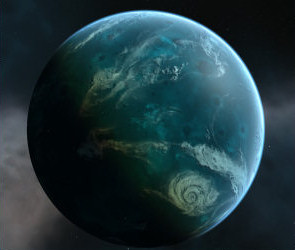
Name: Akkadia II (Akkadia)
Type: Class O - Palegic
Orbital Period: 1.5 years
Axial Tilt: 36 degrees
Eccentricity: 0.008
Satellites/Rings: None - A set of spectacular multicolored rings. No moons (tidal forces broke them up long ago to form rings)
Equatorial Radius: 6,500 km
Polar Radius: 6,458 km
Flattening: 0.0065
Surface Area:
- Land: ~18% - 93,569,181 km2
- Water: ~82% - 426,259,604 km2
Albedo: 0.38
Surface Temperature: ~19 C
Surface Gravity: 0.85 G
Sidereal Rotation Period: 18 hours
Atmosphere:
- Surface Pressure: 101.3 kPa (MSL)
- Composition: 75% Nitrogen (N2), 4% Oxygen (O2), 0.93% Argon, 0.038% CO2, ~3% water vapor
OTHER DATA
- No polar ice except in extreme times.
- Habitats = less diverse than Earth's, on land due to the small amount of land.
- The largest habitats on land are either tropical forest and temperate forest, mixed savanna (scattered trees, groves, or riverine strips in dry grassland), veldt, and alpine vegetation; there is very little desert. - Shallow seas have large coral reefs leading to a rich diversity.
-Salinity 2% - Biomass approximately 133% Sols, most in the sea due to rich diversity of the coral reefs and lush forests.
- Climate belts = The denser air and fast spin creates four convection circulation cells.
- These four convection cells create a torrid zone at the equator, a warm dry zone around 18 degrees north and south, a temperate wet zone around 36, a cool dry zone near 54, and a cold wet zone around 72. - Due to orbit along the solar plane and the rotation of the twin suns creating an eclipsing binary, the result is an eight-season calendar.
- Topographic relief above water is mostly low, but with startling exceptions.
- The highest peak is over 5 km above sea level (20,000'). The greatest depth is approximately 4 km.
- The sea is always near, and most climates are maritime.
- Tropical or temperate lands; very little beyond 60 degrees north or south.
- Narrow, tall, straight coastal ranges
- Plains are dotted with deep lakes.
- Cloud cover is denser (all that extra surface water for the sun to evaporate moisture from).
- Inhabited with a sentient indigenous race.
AKKADIA III
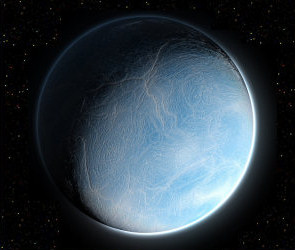
Name: Akkadia III (Hulibria)
Type: Class P - Glaciated
Aphelion: 2.1 AU
Perihelion: 1.98 AU
Eccentricity: 0.0167
Orbital Period: 2 years
Satellites: 3 moons
Mean Radius: 6,380.0 km
Equatorial Radius: 6,378 km
Polar Radius: 6,371 km
Flattening: 0.0011
Circumference: ~40,000 km (mean)
Surface Area: 510,072,000 km2
Volume: 1.083 km3
Mass: 5.9736 x 1022 kg
Mean Density: 5.515 g/cm3
Surface Gravity: 0.997 G
Sidereal Rotation Period: 0.99 days
Axial Tilt: 24.4 degrees
Albedo: 0.39
Surface Temperature: 100 C, 10 C, 47.7 C (max, min, mean)
Atmosphere:
- Surface Pressure: 101.3 kPa (MSL)
- Composition: 78% Nitrogen (N2), 20.95% Oxygen (O2), 0.93% Argon, 0.038% CO2, ~2% water vapor
AKKADIA IV
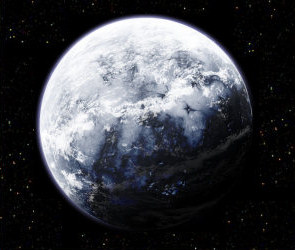
Name: Akkadia IV (Anesidora)
Type: Class N - Reducing
Aphelion: 3.72 AU
Perihelion: 3.72 AU
Semi-major Axis: 108,208,930 km (0.723 AU)
Eccentricity: 0.0068
Orbital Period: 3.7 years
Inclination: 3.394 degrees (71, 3.86 to solar equator)
Mean Radius: 6,051.8 km (0.949 Sols)
Flattening: 0.0002
Surface Area: (0.902 Sols)
Volume: 9.38 km3 (0.857 Sols)
Mass: 4.868 x 1023 kg (0.815 Sols)
Mean Density: 5.204 g/cm3
Equitorial Surface Gravity: 0.904 G
Sidereal Rotation Period: 1.3 days
Axial Tilt: 17.3 degrees
Albedo: 0.68
Surface Temperature: 461.85 C
Atmosphere:
- Surface Pressure: 9.3 MPa
- Composition: 92.0% Carbon dioxide, 4.0% Oxygen, 3.5% Nitrogen, 0.015% Sulfur dioxide, 0.007% Argon, 0.002% Water Vapor, 0.0017% Carbon Monoxide, 0.0012% Helium, 0.0007% Neon, trace Hydrogen Chloride, trace Hydrogen fluoride
OTHER DATA
- Equatorial shield volcano rises 20 miles into the atmosphere to the extent that the upper 20-percent is approximately Class M in conditions.
- The plateau on top of the volcano named Anesidora is a jungle-like landscape.
AKKADIA V
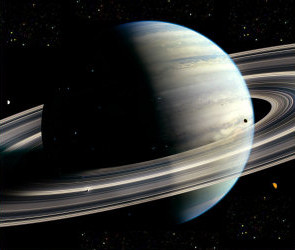
Name: Akkadia V (Lock)
Type: Class T - Gas Giant
Inclination: 1.305 (6.09 to sidereal equator)
Orbital Period: 18.32 years
Inclination: 3.394 degrees (71, 3.86 to solar equator)
Mean Density: 1.326 g/cm3
Sidereal Rotation Period: 15.8 hours
Mass: 0.052 M☉
Radius: 0.22 R☉
Surface Gravity: 6.6 G
Luminosity: 0.001 L
Temperature: 2,200 K
Atmosphere:
- Surface Pressure: 4 - 400 kPa
- Composition: 89.82% Hydrogen, 10.22% Helium, 0.3% Methane, 0.026% Ammonia, 0.003% Hydrogen deuteride, 0.0006% Ethane, 0.0004% water
Satellites/Rings:
- A set of yellowish rings (total of 5 distinct main rings - several fainter smaller rings can be observed)
- 75 satellites of approximately Class D
- Major Satellites: IV - Ryn (Class M)
AKKADIA VI
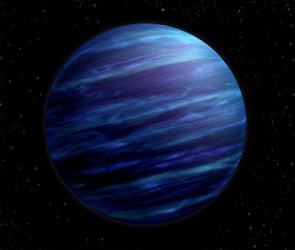
Name: Akkadia VI (Key)
Type: Class I - Ice Giant (Uranian)
Aphelion: 70.4 AU
Perihelion: 69.8 AU
Semi-major Axis: 30.3 AU
Eccentricity: 0.011
Inclination: 1.768 degrees (6.43 to Sun's equator)
Satellites: 13 (10 Class D, 3 Class Y)
Equitorial Radius: 3.93 Sols
Polar Radius: 3.89 Sols
Flattening: 0.0171
Surface Area: 14.98 Sols
Volume: 57.74 Sols
Mass: 17.147 Sols
Mean Density: 1.638 g/cm3
Equitorial Surface Gravity: 1.14 G
Axial Tilt: 28.32 degrees
Albedo: 0.29
Surface Temperature: 1 bar level (max 72 K, average 55 K)
Atmosphere:
- Composition: 80.32% Hydrogen (H2), 19.32% Helium, 1.5% Methane, 0.019% Hydrogen Deuteride, 0.00015% Ethane
Ices:
- Ammonia, Water, Ammonium Hydrosulfide (NH4SH), Methane
AKKADIA VII
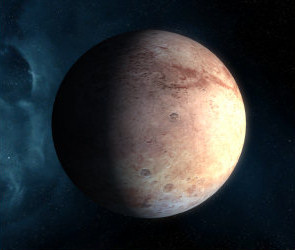
Name: Akkadia VII
Type: Class D - Dwarf
Aphelion: 90.46 AU
Perihelion: 90.31 AU
Semi-major Axis: 87 AU
Eccentricity: 0.205
Inclination: 7.005 degrees (6.43 to Sun's equator)
Satellites: 3
Mean Radius: 0.3829 Sols
Flattening: 0.0006
Surface Area: 0.108 Sols
Volume: 0.054 Sols
Mass: 0.055 Sols
Mean Density: 5.427 g/cm3
Equitorial Surface Gravity: 0.38 G
Axial Tilt: 2.11 degrees
Albedo: 0.119 (bond)
Atmosphere:
- Surface Pressure: Trace
- Composition: 42% Molecular oxygen, 29% sodium, 22% hydrogen, 6% helium, 0.5% potassium, trace amounts of argon, nitrogen, carbon dioxide, water vapor, xenon, krypton
2.2 Rojar System
Figure 2.2.1 - Major Rojar system planetary bodies (click to enlarge)
Figure 2.2.2 - Rojar system perspective view (click to enlarge)
Figure 2.2.3 - Rojar system ZY axis view (click to enlarge)
Figure 2.2.4 - Rojar system XY axis view (click to enlarge)
Figure 2.2.4 - Rojar system inner system view (click to enlarge)
PRIMARY STAR
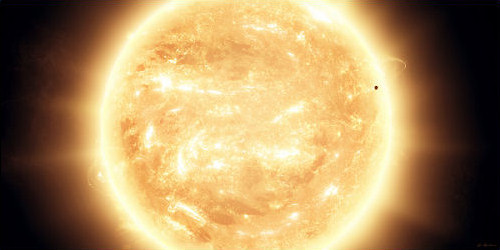
Name: Rojar 861
Type: Spectral Class G1V
System Location: Core
Galactic Position: Sector 025 Block 292 Grid 04
Discovered: 2389 by USS Venture
Charted: 2389 by USS Galileo
Age: 4.82 B years
Mass: 0.89 M☉
Diameter: 1.33 M km
Density: 1.41 g/cm3
Temperature: 5,899 K
Luminosity: 0.97 L☉
Composition: Hydrogen, Helium
Rotational Period: 59.3 days
Axis Rotation (x,y,z): (6.83, -2.52, -20.4) degrees
Rojar I
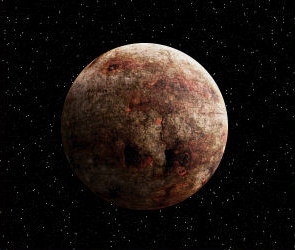
Name: Rojar I
Type: Class B - Geomorteus
Survey Status: Charted (USS Galileo)
System Location: Hot Zone
Relative Position (x,y,z): (60.8, -47.1, 1.11) M km
Age: 4.2 B years
Mass: 4.49 moons
Diameter: 4,880 km
Density: 5.42 g/cm3
Velocity: 34 km/s
Temperature: 120 C
Composition: Silicate, Iron
Atmosphere: Helium, Sodium
Satellites: None
Rings: None
Orbital Radius: 66.2 M km
Orbital Eccentricity: 0.22
Orbital Period: 117 days
Rotational Period: 59.3 days
Rotation (x,y,z): (-0.06, -0.08, -126) degrees
Rojar II
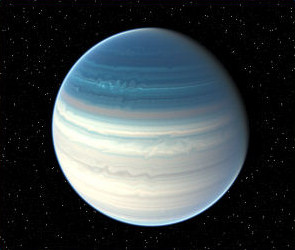
Name: Rojar II
Type: Class S - Supergiant
Survey Status: Charted (USS Galileo)
System Location: Habitable Zone
Relative Position (x,y,z): (78.6, 117, 0.01) M km
Age: 3.4 B years
Mass: 51.0 Jupiters
Diameter: 518,520 km
Density: 1.33 g/cm3
Velocity: 29 km/s
Temperature: -130 C
Composition: Metallic hydrogen, Helium, Ice (core)
Atmosphere: None
Satellites: 81 moons
Rings: 1 (A ring)
Orbital Radius: 136 M km
Orbital Eccentricity: 0.04
Orbital Period: 329 days
Rotational Period: 2.9 days
Rotation (x,y,z): (2.77, -1.44, -27.4) degrees
Rojar III
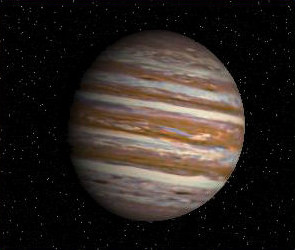
Name: Rojar III
Type: Class J - Gas Giant (Jovian)
Survey Status: Charted (USS Galileo)
System Location: Inner Belt
Relative Position (x,y,z): (1.4, -3.97, 0.001) AU
Age: 3.67 B years
Mass: 0.80 Jupiters
Diameter: 120,803 km
Density: 0.65 g/cm3
Velocity: 13.5 km/s
Temperature: -134 C
Composition: Helium, Liquid metallic hydrogen (core)
Atmosphere: None
Satellites: 28 moons
Rings: None
Orbital Radius: 4.49 AU
Orbital Eccentricity: 0.05
Orbital Period: 10.2 years
Rotational Period: 1.3 days
Rotation (x,y,z): (2.2, 17, 28.3) degrees
Inner Asteroid Belt
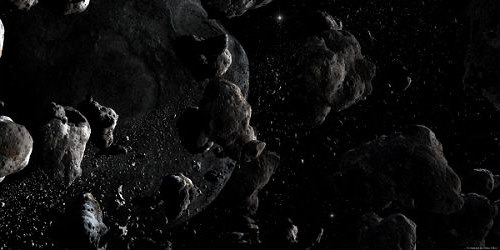
Name: Inner Asteroid Belt
Min Orbital Radius: 5.65 AU
Max Orbital Radius: 8.02 AU
System Location: Cold Zone
Total Asteroids: 23,818
C-type: 19,782
S-type: 3,133
M-type: 832
Other: 71
Rojar IV
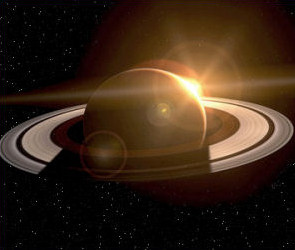
Name: Rojar IV
Type: Class J - Gas Giant (Jovian)
Survey Status: Charted (USS Galileo)
System Location: Cold Zone
Relative Position (x,y,z): (8.8, 8.67, -0.04) AU
Age: 3.2 B years
Mass: 0.71 Jupiters
Diameter: 116,886 km
Density: 0.69 g/cm3
Velocity: 7.96 km/s
Temperature: -191 C
Composition: Helium, Liquid metallic hydrogen (core)
Atmosphere: None
Satellites: 15 moons
Rings: 4 (A, B, C, D Rings)
Orbital Radius: 12.4 AU
Orbital Eccentricity: 0.11
Orbital Period: 46.5 years
Rotational Period: 0.34 days
Rotation (x,y,z): (19.2, 19, 46.4) degrees
Rojar V
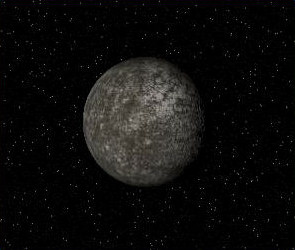
Name: Rojar V
Type: Class C - Geoinactive
Survey Status: Charted (USS Galileo)
System Location: Cold Zone
Relative Position (x,y,z): (-20.3, 13.1, -0.001) AU
Age: 3.27 B years
Mass: 0.73 Earths
Diameter: 7,263 km
Density: 3.92 g/cm3
Velocity: 5.68 km/s
Temperature: -215 C
Composition: Rock, Metal, Ice
Atmosphere: None
Satellites: 2 moons
Rings: None
Orbital Radius: 24.2 AU
Orbital Eccentricity: 0.01
Orbital Period: 127 years
Rotational Period: 1.71 days
Rotation (x,y,z): (-55.5, -104, -78.2) degrees
Rojar VI
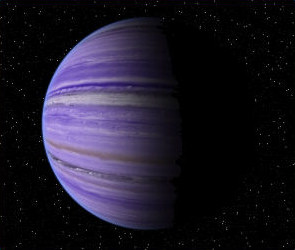
Name: Rojar V
Type: Class I - Ice Giant (Uranian)
Survey Status: Charted (USS Galileo)
System Location: Perimeter
Relative Position (x,y,z): (5.68, 28.4, -2.1) AU
Age: 2.90 B years
Mass: 0.23 Jupiters
Diameter: 52,330 km
Density: 1.64 g/cm3
Velocity: 5.30 km/s
Temperature: -221 C
Composition: Hydrogen, Helium, Methane, Ammonia, Ice (core)
Atmosphere: None
Satellites: 18 moons
Rings: None
Orbital Radius: 30.4 AU
Orbital Eccentricity: 0.05
Orbital Period: 178 years
Rotational Period: 0.79 days
Rotation (x,y,z): (12.7, 27.0, 66.6) degrees
Outer Asteroid Belt
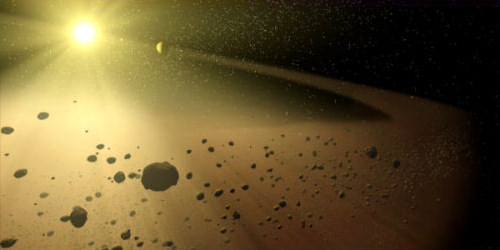
Name: Outer Asteroid Belt
Min Orbital Radius: 33.42 AU
Max Orbital Radius: 36.94 AU
System Location: Perimeter
Total Asteroids: 20,455
C-type: 16,284
S-type: 2,013
M-type: 1,027
Other: 1,131
2389 BP1
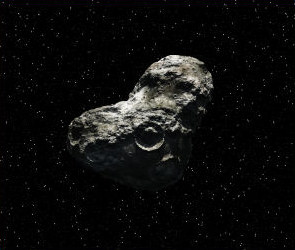
Name: 2389 BP1
Type: C-type Asteroid - Carbonaceous
Survey Status: Charted (USS Galileo)
System Location: Perimeter
Relative Position (x,y,z): (-28.0, 18.2, -15.5) AU
Age: 1.01 B years
Mass: 27,002 M kg
Diameter: 270 km
Density: 2.62 g/cm3
Velocity: 4.58 km/s
Temperature: -226 C
Composition: Carbon, Silicate
Atmosphere: None
Resources: Unknown
Orbital Radius: 36.6 AU
Orbital Eccentricity: 0.32
Orbital Period: 236 years
Rotational Period: 6.62 days
Rotation (x,y,z): (-36, -133, 28.6) degrees
2389 BP2
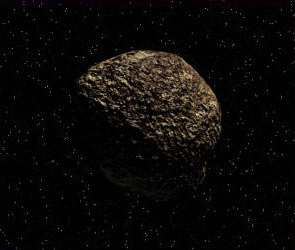
Name: 2389 BP2
Type: S-type Asteroid - Stony
Survey Status: Charted (USS Galileo)
System Location: Perimeter
Relative Position (x,y,z): (19.1, 12.7, 0.014) AU
Age: 0.39 B years
Mass: 2.14 x 1020 kg
Diameter: 532 km
Density: 2.71 g/cm3
Velocity: 5.22 km/s
Temperature: -213 C
Composition: Silicate (Iron, Magnesium)
Atmosphere: None
Resources: Unknown
Orbital Radius: 19.1 AU
Orbital Eccentricity: 0.33
Orbital Period: 88.9 years
Rotational Period: 0.58 days
Rotation (x,y,z): (57.3, 22.8, -26.6) degrees
2389 BP3
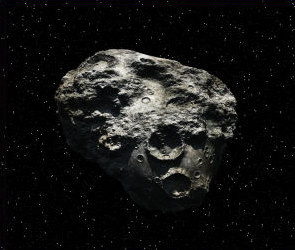
Name: 2389 BP3
Type: C-type Asteroid - Carbonaceous
Survey Status: Charted (USS Galileo)
System Location: Cold Zone
Relative Position (x,y,z): (-24.8, -14, 3.70) AU
Age: 1.05 B years
Mass: 1.64 x 1020 kg
Diameter: 487 km
Density: 2.98 g/cm3
Velocity: 5.29 km/s
Temperature: -219 C
Composition: Carbon, Silicate
Atmosphere: None
Resources: Unknown
Orbital Radius: 29.6 AU
Orbital Eccentricity: 0.51
Orbital Period: 127 years
Rotational Period: 3.1 days
Rotation (x,y,z): (-58.1, -19.1, -158) degrees
2389 BP4
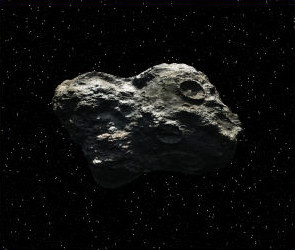
Name: 2389 BP4
Type: C-type Asteroid - Carbonaceous
Survey Status: Charted (USS Galileo)
System Location: Cold Zone
Relative Position (x,y,z): (6.70, 7.28, -11.3) AU
Age: 0.29 B years
Mass: 92,105 M kg
Diameter: 406 km
Density: 2.69 g/cm3
Velocity: 7.39 km/s
Temperature: -199 C
Composition: Carbon, Silicate
Atmosphere: None
Resources: Unknown
Orbital Radius: 15.7 AU
Orbital Eccentricity: 0.05
Orbital Period: 66.5 years
Rotational Period: 0.96 days
Rotation (x,y,z): (6.79, 95.8, -76.4) degrees
2389 BP5
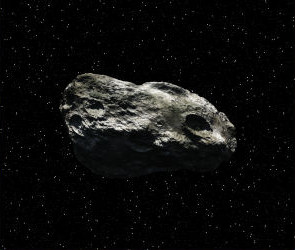
Name: 2389 BP5
Type: M-type Asteroid - Metallic
Survey Status: Charted (USS Galileo)
System Location: Cold Zone
Relative Position (x,y,z): (13.7, -9.94, 3.87) AU
Age: 2.33 B years
Mass: 2.66 x 1020 kg
Diameter: 530 km
Density: 3.42 g/cm3
Velocity: 6.57 km/s
Temperature: -204 C
Composition: Nickel, Iron
Atmosphere: None
Resources: Unknown
Orbital Radius: 16.8 AU
Orbital Eccentricity: 0.35
Orbital Period: 73.2 years
Rotational Period: 5.07 days
Rotation (x,y,z): (-52.8, 105.6, -74.1) degrees
2389 BP6
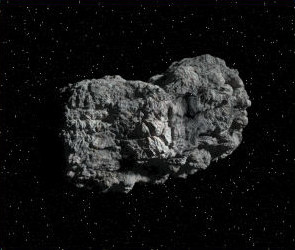
Name: 2389 BP6
Type: M-type Asteroid - Metallic
Survey Status: Charted (USS Galileo)
System Location: Cold Zone
Relative Position (x,y,z): (-15.4, -1.75, 3.35) AU
Age: 0.53 B years
Mass: 1.02 x 1020 kg
Diameter: 385 km
Density: 3.50 g/cm3
Velocity: 5.18 km/s
Temperature: -201 C
Composition: Nickel, Iron
Atmosphere: None
Resources: Unknown
Orbital Radius: 10.9 AU
Orbital Eccentricity: 0.47
Orbital Period: 38.2 years
Rotational Period: 0.92 days
Rotation (x,y,z): (88.6, 93.2, 141) degrees
2389 BP7
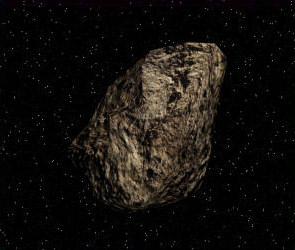
Name: 2389 BP7
Type: S-type Asteroid - Stony
Survey Status: Charted (USS Galileo)
System Location: Cold Zone
Relative Position (x,y,z): (11.1, -1.03, 0.009) AU
Age: 0.14 B years
Mass: 5.69 x 1020 kg
Diameter: 737 km
Density: 2.71 g/cm3
Velocity: 9.24 km/s
Temperature: -187 C
Composition: Silicate (Iron, Magnesium)
Atmosphere: None
Resources: Unknown
Orbital Radius: 14.3 AU
Orbital Eccentricity: 0.51
Orbital Period: 57.7 years
Rotational Period: 12.5 days
Rotation (x,y,z): (59.0, 15.4, 17.8) degrees
C/2389 A1
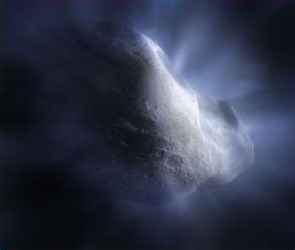
Name: C/2389 A1 (Saalm)
Type: Long Period Comet
Survey Status: Charted (USS Galileo)
System Location: Perimeter
Relative Position (x,y,z): (9.53, 13, 3.63) AU
Age: 3.63 B years
Mass: 2.20 x 1020 kg
Diameter: 543 km
Density: 2.62 g/cm3
Velocity: 8.74 km/s
Temperature: -230 C
Composition: Ice, Ammonia, Methane
Atmosphere: None
Lifeforms: None
Resources: Unknown
Orbital Radius: Variable
Orbital Eccentricity: 0.62
Orbital Period: 298 years
Rotational Period: 23.6 days
Rotation (x,y,z): (2.04, -76.9, 148) degrees
2.3 Sol System
Figure 2.3.1 - Major Sol system planetary bodies
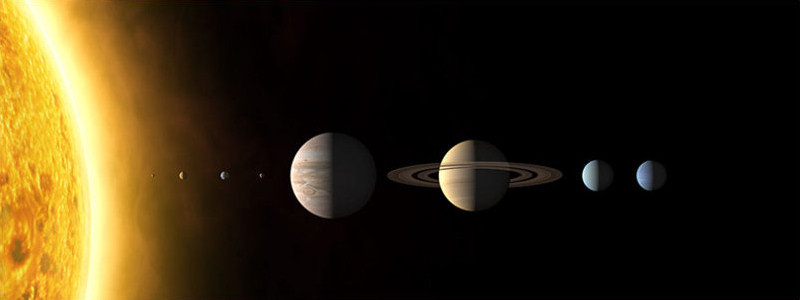
PRIMARY STAR
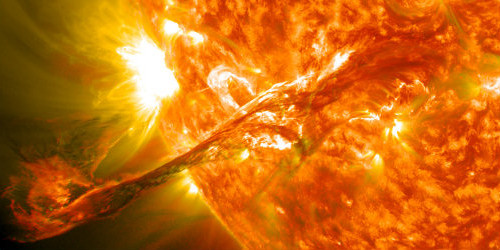
Name: Sol (The Sun)
Type: Spectral Class G2V
System Location: Core
Galactic Position: Sector 001 Block 051 Grid 13
Age: 4.6 B years
Mass: 1.00 Sols
Diameter: 1.39 M km
Density: 1.41 g/cm3
Temperature: 5,778 K
Luminosity: 1.00 L☉
Composition: Hydrogen, Helium
Rotational Period: 25.4 days
Axis Rotation (x,y,z): (7.25, 0, 0) degrees
Sol I
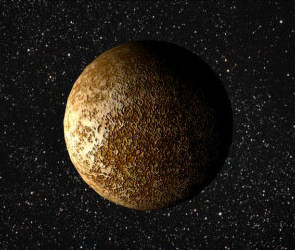
Name: Sol I (Mercury)
Type: Class B - Geomorteus
Survey Status: Charted by Mariner 10 (NASA) in 1975
System Location: Hot Zone
Relative Position (x,y,z): (38.9, -50, -0.007) M km
Age: 4.53 B years
Mass: 4.49 moons
Diameter: 4,880 km
Density: 5.43 g/cm3
Velocity: 43.2 km/s
Temperature: 170 C
Composition: Silicate, Iron (core)
Atmosphere: Carbon Dioxide, Nitrogen
Satellites: None
Rings: None
Orbital Radius: 57.9 M km
Orbital Eccentricity: 0.21
Orbital Period: 88 days
Rotational Period: 58.6 days
Rotation (x,y,z): (0.1, 0, 0) degrees
Sol II
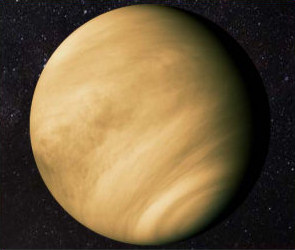
Name: Sol II (Venus)
Type: Class N - Reducing
Survey Status: Charted by Magellan (NASA) in 1990
System Location: Hot Zone
Relative Position (x,y,z): (-107, -6.07, 0.006) M km
Age: 4.52 B years
Mass: 0.82 Earths
Diameter: 12,104 km
Density: 5.24 g/cm3
Velocity: 35.2 km/s
Temperature: 462 C
Composition: Silicate, Iron (core)
Atmosphere: Carbon Dioxide
Satellites: None
Rings: None
Orbital Radius: 108 M km
Orbital Eccentricity: 0.001
Orbital Period: 225 days
Rotational Period: 243 days
Rotation (x,y,z): (177, 0, 0) degrees
Sol III
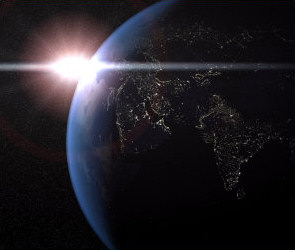
Name: Sol III (Earth)
Type: Class M - Terrestrial
Survey Status: Charted
System Location: Habitable Zone
Relative Position (x,y,z): (-25.1, 145, 0.002) M km
Age: 4.54 B years
Mass: 1.0 Earths
Diameter: 12,742 km
Density: 5.51 g/cm3
Velocity: 30.3 km/s
Temperature: 17.8 C
Composition: Silicate, Iron (core)
Atmosphere: Nitrogen, Oxygen
Satellites: 1 moon (Luna)
Rings: None
Orbital Radius: 1.0 AU
Orbital Eccentricity: 0.02
Orbital Period: 365 days
Rotational Period: 23.9 hours
Rotation (x,y,z): (23.5, 0, 0) degrees
Sol IV
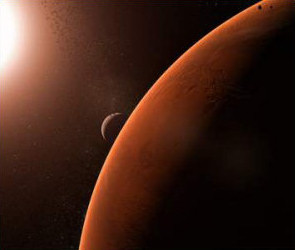
Name: Sol IV (Mars)
Type: Class K - Adaptable
Survey Status: Charted by Mariner 6 & 7 (NASA) in 1969
System Location: Cold Zone
Relative Position (x,y,z): (-24.7, 234.9, 5.54) M km
Age: 4.52 B years
Mass: 0.53 Earths
Diameter: 6,788 km
Density: 3.92 g/cm3
Velocity: 23.2 km/s
Temperature: -44.1 C
Composition: Silicate, Iron (core)
Atmosphere: Carbon Dioxide, Argon
Satellites: 2 moons (Phobos, Deimos)
Rings: None
Orbital Radius: 1.52 AU
Orbital Eccentricity: 0.09
Orbital Period: 1.88 years
Rotational Period: 1.03 days
Rotation (x,y,z): (25.2, 0, 0) degrees
Main Asteroid Belt
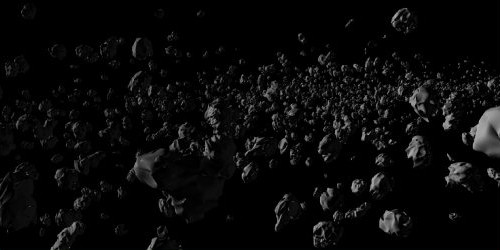
Name: Main Asteroid Belt
Min Orbital Radius: 1.98 AU
Max Orbital Radius: 4.02 AU
System Location: Cold Zone
Total Asteroids: 780,596
C-type: 665,447
S-type: 97,963
M-type: 17,574
Dwarf Planets: Ceres, Pallas, Vesta, Hygiea, Juno
Sol V
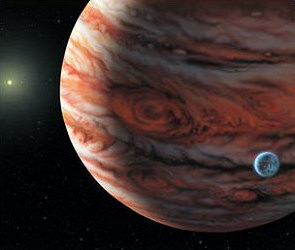
Name: Sol V (Jupiter)
Type: Class J - Gas Giant (Jovian)
Survey Status: Charted by Voyager 1 & 2 (NASA) in 1979
System Location: Cold Zone
Relative Position (x,y,z): (22.2, -785.4, 2.76) M km
Age: 4.53 B years
Mass: 1.0 Jupiters
Diameter: 139,822 km
Density: 1.33 g/cm3
Velocity: 13.0 km/s
Temperature: -147 C
Composition: Liquid metallic hydrogen, Helium, Rock (core)
Atmosphere: Hydrogen, Helium
Satellites: 66 moons (Io, Europa, Ganymede, Callisto, more)
Rings: 4 (A, B, C, D rings)
Orbital Radius: 5.20 AU
Orbital Eccentricity: 0.05
Orbital Period: 11.9 years
Rotational Period: 9.93 hours
Rotation (x,y,z): (3.12, 0, 0) degrees
Sol VI
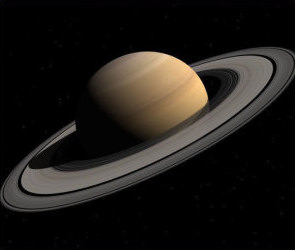
Name: Sol VI (Saturn)
Type: Class J - Gas Giant (Jovian)
Survey Status: Charted by Cassini (NASA) in 2004
System Location: Cold Zone
Relative Position (x,y,z): (-8.26, 4.19, 0.26) AU
Age: 4.51 B years
Mass: 0.84 Jupiters
Diameter: 116,464 km
Density: 0.69 g/cm3
Velocity: 9.92 km/s
Temperature: -179 C
Composition: Liquid metallic hydrogen, Helium, Rock (core)
Atmosphere: Hydrogen, Helium
Satellites: 53 moons (Titan, Rhea, Dione, Mimas, Enceladus, more)
Rings: 6 (D, C, B, A, F, G rings)
Orbital Radius: 9.54 AU
Orbital Eccentricity: 0.05
Orbital Period: 29.4 years
Rotational Period: 10.7 hours
Rotation (x,y,z): (26.7, 0, 0) degrees
Sol VII
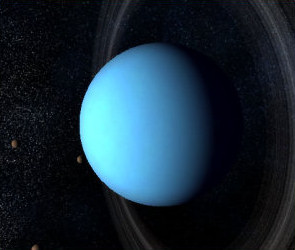
Name: Sol VII (Uranus)
Type: Class I - Ice Giant (Uranian)
Survey Status: Charted by Voyager 2 (NASA) in 1986
System Location: Cold Zone
Relative Position (x,y,z): (19.6, -4.24, 0.27) AU
Age: 4.51 B years
Mass: 14.5 Earths
Diameter: 50,724 km
Density: 1.27 g/cm3
Velocity: 6.49 km/s
Temperature: -209 C
Composition: Methane, Ammonia, Ice, Rock (core)
Atmosphere: Hydrogen, Helium, Methane
Satellites: 27 moons (Miranda, Titania, Umbriel, Ariel, Cupid, more)
Rings: 13 rings
Orbital Radius: 19.2 AU
Orbital Eccentricity: 0.04
Orbital Period: 84.2 years
Rotational Period: 17.2 hours
Rotation (x,y,z): (97.9, 0, 0) degrees
Sol VIII
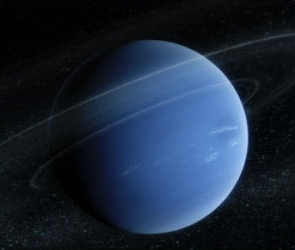
Name: Sol VIII (Neptune)
Type: Class I - Ice Giant (Uranian)
Survey Status: Charted by Voyager 2 (NASA) in 1989
System Location: Cold Zone
Relative Position (x,y,z): (23.5, -18.8, 0.15) AU
Age: 4.51 B years
Mass: 17.1 Earths
Diameter: 49,248 km
Density: 1.64 g/cm3
Velocity: 5.45 km/s
Temperature: -221 C
Composition: Methane, Ammonia, Ice, Rock (core)
Atmosphere: Hydrogen, Helium, Methane
Satellites: 13 moons (Triton, Proteus, Larissa, more)
Rings: 4 rings
Orbital Radius: 30.2 AU
Orbital Eccentricity: 0.01
Orbital Period: 166 years
Rotational Period: 16.1 hours
Rotation (x,y,z): (29.6, 0, 0) degrees
Kuiper Belt
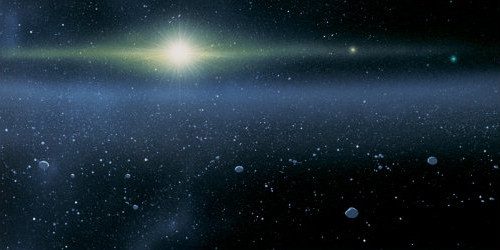
Name: Kuiper Belt
Min Orbital Radius: 29.85 AU
Max Orbital Radius: 50.08 AU
System Location: Cold Zone
Total Asteroids: 1,170,894
C-type: 590,298
S-type: 2,013
M-type: 574,331
Dwarf Planets: Eris, Pluto, Makemake, Haumea, Sedna
1P/Halley
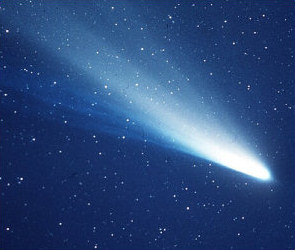
Name: Halley's Comet
Type: Short-period Comet
Discovered: Edmund Halley (1705)
System Location: Variable
Age: 4.6 B years
Diameter: 14 km
Density: 0.60 g/cm3
Velocity: 70.6 km/s
Temperature: Variable
Composition: Ice, Ammonia, Methane
Atmosphere: None
Orbital Period: 75 years
C/1995 O1
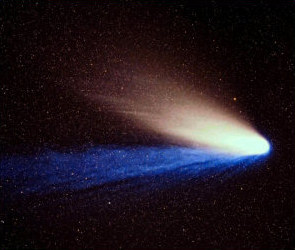
Name: Hale-Bopp
Type: Long-Period Comet
Discovered: Alan Hale/Thomas Bopp (1995)
System Location: Variable
Age: 4.5 B years
Diameter: 65 km
Density: 0.62 g/cm3
Velocity: 52.9 km/s
Temperature: Variable
Composition: Ice, Ammonia, Methane
Atmosphere: None
Orbital Period: 2,537 years
Oort Cloud
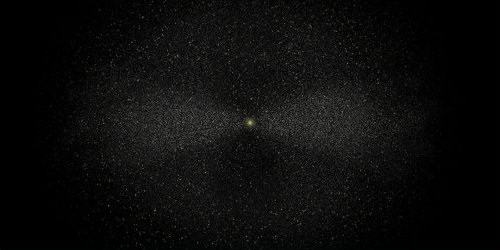
Name: Oort Cloud
Min Orbital Radius: 3,500 AU
Max Orbital Radius: 50,000 AU
System Location: Perimeter
Total Satellites: > 1 billion
Categories: Science Manual


